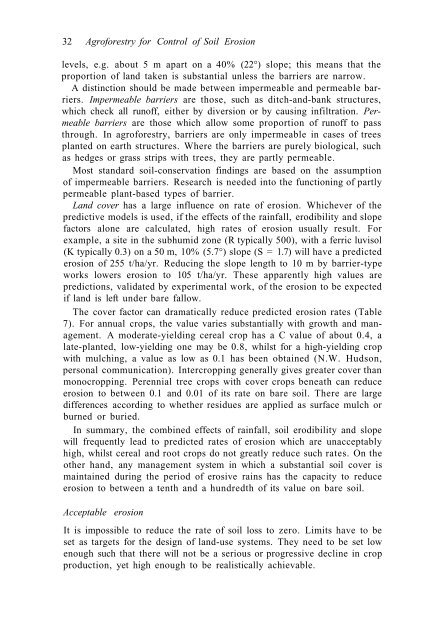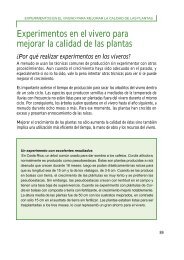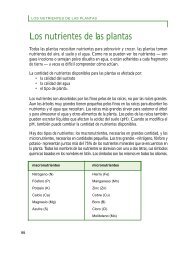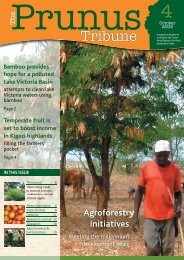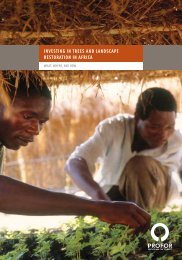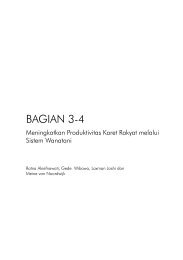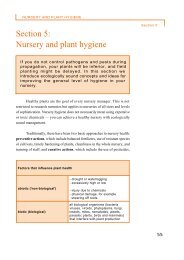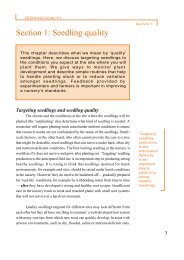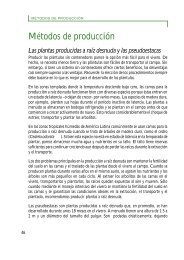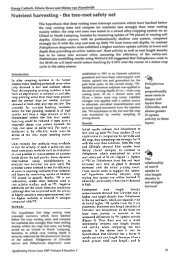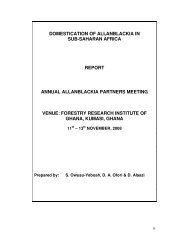Agroforestry for Soil Conservation - World Agroforestry Centre
Agroforestry for Soil Conservation - World Agroforestry Centre
Agroforestry for Soil Conservation - World Agroforestry Centre
You also want an ePaper? Increase the reach of your titles
YUMPU automatically turns print PDFs into web optimized ePapers that Google loves.
32 <strong>Agro<strong>for</strong>estry</strong> <strong>for</strong> Control of <strong>Soil</strong> Erosion<br />
levels, e.g. about 5 m apart on a 40% (22°) slope; this means that the<br />
proportion of land taken is substantial unless the barriers are narrow.<br />
A distinction should be made between impermeable and permeable barriers.<br />
Impermeable barriers are those, such as ditch-and-bank structures,<br />
which check all runoff, either by diversion or by causing infiltration. Permeable<br />
barriers are those which allow some proportion of runoff to pass<br />
through. In agro<strong>for</strong>estry, barriers are only impermeable in cases of trees<br />
planted on earth structures. Where the barriers are purely biological, such<br />
as hedges or grass strips with trees, they are partly permeable.<br />
Most standard soil-conservation findings are based on the assumption<br />
of impermeable barriers. Research is needed into the functioning of partly<br />
permeable plant-based types of barrier.<br />
Land cover has a large influence on rate of erosion. Whichever of the<br />
predictive models is used, if the effects of the rainfall, erodibility and slope<br />
factors alone are calculated, high rates of erosion usually result. For<br />
example, a site in the subhumid zone (R typically 500), with a ferric luvisol<br />
(K typically 0.3) on a 50 m, 10% (5.7°) slope (S = 1.7) will have a predicted<br />
erosion of 255 t/ha/yr. Reducing the slope length to 10 m by barrier-type<br />
works lowers erosion to 105 t/ha/yr. These apparently high values are<br />
predictions, validated by experimental work, of the erosion to be expected<br />
if land is left under bare fallow.<br />
The cover factor can dramatically reduce predicted erosion rates (Table<br />
7). For annual crops, the value varies substantially with growth and management.<br />
A moderate-yielding cereal crop has a C value of about 0.4, a<br />
late-planted, low-yielding one may be 0.8, whilst <strong>for</strong> a high-yielding crop<br />
with mulching, a value as low as 0.1 has been obtained (N.W. Hudson,<br />
personal communication). Intercropping generally gives greater cover than<br />
monocropping. Perennial tree crops with cover crops beneath can reduce<br />
erosion to between 0.1 and 0.01 of its rate on bare soil. There are large<br />
differences according to whether residues are applied as surface mulch or<br />
burned or buried.<br />
In summary, the combined effects of rainfall, soil erodibility and slope<br />
will frequently lead to predicted rates of erosion which are unacceptably<br />
high, whilst cereal and root crops do not greatly reduce such rates. On the<br />
other hand, any management system in which a substantial soil cover is<br />
maintained during the period of erosive rains has the capacity to reduce<br />
erosion to between a tenth and a hundredth of its value on bare soil.<br />
Acceptable erosion<br />
It is impossible to reduce the rate of soil loss to zero. Limits have to be<br />
set as targets <strong>for</strong> the design of land-use systems. They need to be set low<br />
enough such that there will not be a serious or progressive decline in crop<br />
production, yet high enough to be realistically achievable.


